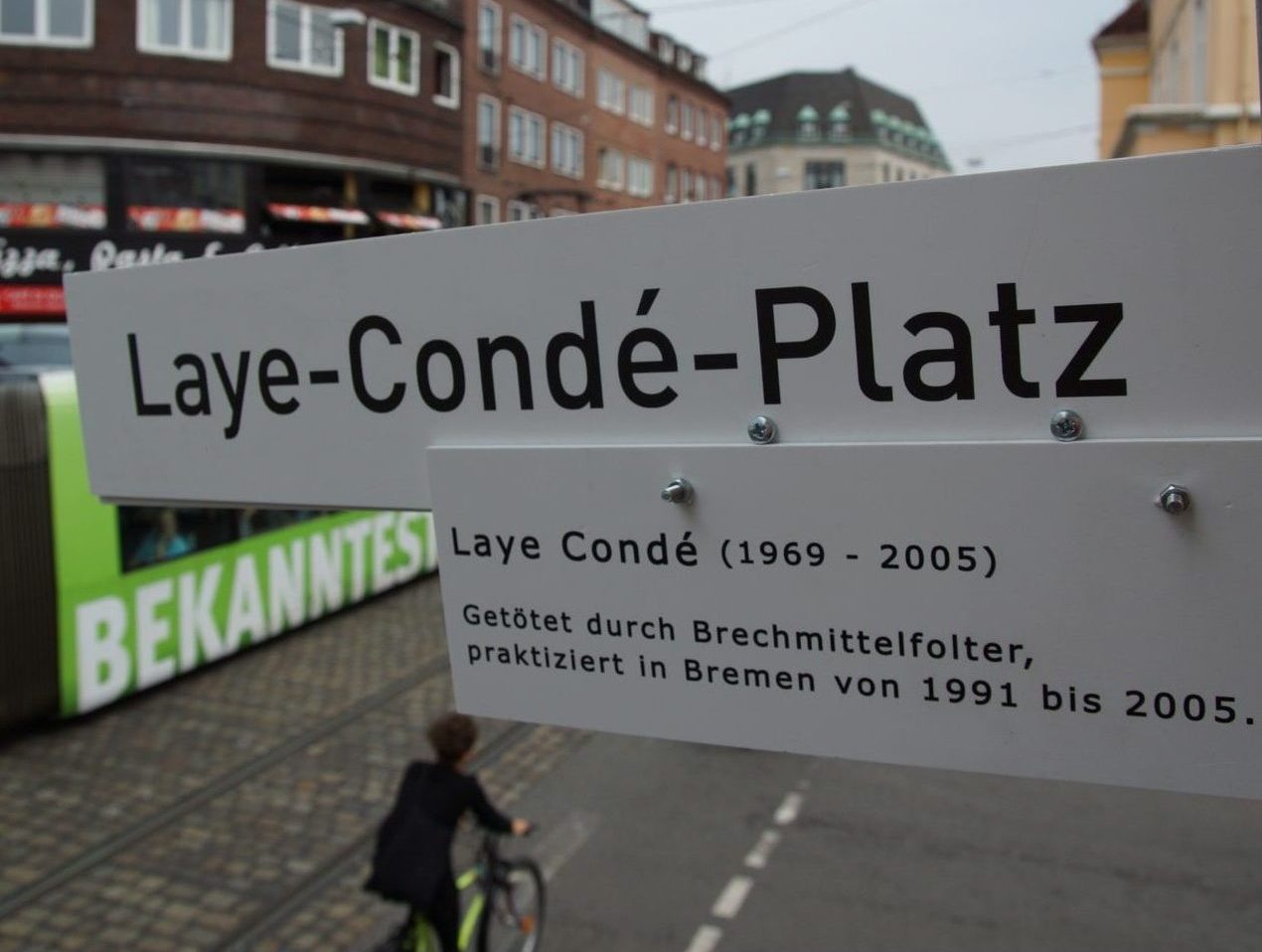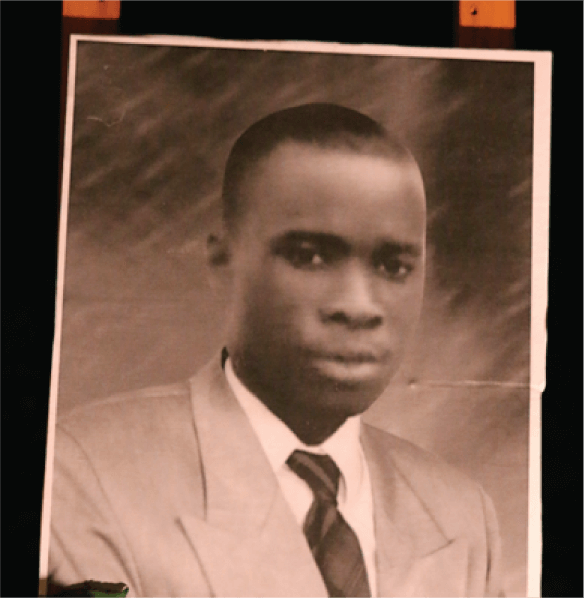13 Years of emetic torture
The road to the official place of commemoration
In 2020, the Bremen Parliament decided to establish a place of remembrance. A selection committee was set up and an art competition organized. Here is our press release (in German) of 7.11.2023 concerning the announcement of the selected project
Commemoration Day January 7, 2026
Compensation for all people affected!
Laye Condé was killed by the administration of emetics. All other people affected have survived this torture situation with damage to their physical and mental health. They also have a right to compensation.
Not an isolated case
Selected media reports
Over the years, many articles have appeared on the topic of emetic torture and Laye Condé. Here is a selection focusing on institutional racism, responsibility, reappraisal.

Emetic torture 1991 – 2006
- 1991 In Bremen, police doctor Männche injects victims with emetics for the first time without an official order.
- 1992 The distribution of emetics is institutionalized by the Bremen coalition (Ampelkoalition: SPD, FDP, Green Party). Over the next three years, emetics are administered to victims more than 400 times.
- 1995 Abu Bakah Jalloh from Wuppertal defends himself legally with a complaint against the forced administration of emetics to him.
- 1995 The Anti-Rassismus-Büro Bremen (Anti-Racism Office Bremen – ARAB) writes an open letter to Justice Senator Scherf demanding that the practice be stopped, and documents reports from those affected in the brochure “Polizisten, die zum Brechen reizen” (Policemen who provoke vomiting). As a result, two ARAB activists are investigated for “incitement of the people,” and the brochure is confiscated during a house search.
- 1991-1995 The ARAB files a good dozen criminal complaint against those involved in the vomit system. All preliminary proceedings are dropped by the public prosecutor’s office.
- 1995 Chief Public Prosecutor Frischmuth declares the practice of dispensing emetics to be legitimate – despite critical voices from doctors and those affected – and orders its continuation.
- 1996 The Bremer Ärztekammer (Bremen Medical Chamber) finally declares the distribution of emetics to be “compatible with the professional ethics of physicians”.
- 1996 The Higher Regional Court in Frankfurt/Main rules that the use of emetics to preserve evidence is unlawful because it occurs “entirely without legal basis” and is not covered by the Code of Criminal Procedure.
- 1999 Abu Bakah Jalloh files a constitutional complaint with the Federal Constitutional Court (BVerfG). The BVerfG refuses to accept the complaint on formal grounds, stating that emetic operations “do not raise any fundamental constitutional objections with regard to human dignity […]”. The BVerfG explicitly does not comment on “the extent to which compulsory administration is permissible with regard to the protection of physical integrity and the proportionality of the intervention.”
- 2000 Mr. Jalloh submits an individual complaint to the European Court of Human Rights (ECHR).
- 2001 Achidi John is killed on December 12 in Hamburg during a forced administration of emetics. One day later, the BVerfG clarifies in a press release that – contrary to press reports – that it had not established the constitutionality of the compulsory administration of emetics in 1999.
- 2001 On December 13, the parliamentary group of the Green Party in Bremen’s state parliament moves a motion to end the practice of administering emetics immediately. The SPD, CDU and DVU reject the motion. The forced distribution of emetics is continued.
- 2005 By this year, a total of more than 1,000 emetics are administered in Bremen. Bremen is the birthplace and capital of emetic torture.
- 2005 Laye Alama Condé dies in Bremen as a result of emetic use under duress. The state parliament of Bremen (Bürgerschaft) suspends the use of emetics.
- 2006 The ECtHR upholds Mr. Jalloh’s complaint (11 years after his first complaint) and finds that the use of emetics is inhumane and degrading and violates the ban on torture.
Laye Condé
1969 – 2005
- 1969 Laye Condé is born in Kabala/Sierra Leone as the first child of his family. He has several siblings.
- 2000 At the age of 31, he decides to flee to Europe due to the local political and socio-economic situation.
- 2001 Laye Condé arrives in Hamburg and is redistributed to Bremen. His asylum application is rejected.
- 2001-2004 Laye Condé lives in a collective accommodation for refugees on the outskirts of Bremen. His roommates and friends describe him as a quiet, politically interested person. He is banned from working and is not allowed to leave Bremen without written permission from the foreigners registration office.
- 2004 On the evening of December 27, Laye Condé is arrested by two Neustadt police officers in Bremen’s “Viertel” district and taken to police custody. There, with the help of the two policemen, the doctor Igor V. subjects him to an excruciating emetic ordeal: more than seven liters of emetic syrup and water are fed into his nose through a stomach tube against his will. Even after Laye Condé has already fallen into a coma, the torture continues because the doctor and the police officers are convinced that it is a simulation. Only after more than two hours is Laye Condé admitted to a hospital, where pulmonary edema and brain damage are diagnosed.
- 2005 On January 7, Laye Condé dies at St. Joseph-Stift in Bremen of “celebral hypoxia secondary to drowning after aspiration during forced vomiting.” Laye Condé was drowned by the state through the violent administration of emetics.
- Seit 2006 On the anniversary of Laye Condé’s death, public commemorative events have been held annually in Bremen.
Bremen Trials 2006 – 2013
- 2006 The Bremen Public Prosecutor’s Office brings charges against Igor V., an employee of the Medical Evidence Preservation Service. Accusation: negligent homicide.
- 2007 In the course of an out-of-court settlement, the City of Bremen pays 10,000 Euros to Laye Condé’s mother – compensation for pain and suffering that Mr. Condé himself would have been entitled to. The amount of the payment is based on the same amount that the ECHR awarded Abu Bakah Jalloh in 2006.
- 2008 The first emetic trial against the doctor begins at the Bremen Regional Court in the presence of Fatma Tarawalli, Laye Condé’s mother, and his brother Namantjan Condé. The trial ends with an acquittal of the defendant. Igor V. had committed “objective professional errors” that were “causal” for Laye Condé’s death. But Igor V. had been “overtaxed due to a lack of experience” and thus “far removed from the model of an experienced medical specialist to which case law is oriented as a standard for negligence offenses.” Ms. Tarawalli’s attorney files an appeal with the Federal Supreme Court (BGH).
- 2010 The BGH allows the appeal and refers the case back to the Bremen Regional Court. It suggests that other parties besides Igor V. might have to answer to the court and that the case should be assessed as bodily injury resulting in death (a more serious criminal offense).
- 2011 In March the second emetic trial begins, in June it ends again with the acquittal of the doctor. The reasoning now: the cause of death could not be clearly established – even though there was much to suggest that Laye Condé had drowned slowly. Ms. Tarawalli’s lawyer appeals to the Federal Supreme Court for the second time.
- 2012 The BGH again overturns the verdict of the Bremen Regional Court, calling it “fast grotesk falsch” (almost grotesquely wrong).
- 2013 In April, the third emetic trial begins. Months later, a responsible politician, the former mayor Scherf, is heard as a witness for the first time. He refers to the emetic distribution as “Beweissicherungsalltag” (“daily life evidence preservation”). In November, the trial is finally closed due to Igor V.’s inability to stand trial. The defendant must pay € 20,000 to Ms. Tarawalli.
- Since 2010 , “the Laye Condé case” has been part of legal education at universities. The three “Bremer Brechmittelprozesse” (Bremen emetic trials) have written legal history – also because the appeal of the ancillary action in a criminal case was granted twice by the Federal Supreme Court (BGH). This is still unique in the Federal Republic of Germany.
Steps towards reappraisal
- 2005 One week after Laye Condé’s death, over 2,000 people demonstrate in Bremen against racist police violence.
- Since 2006 On the anniversary of Laye Condé’s death, activists organize public commemoration events in Bremen. In the first years, the “Caravan for the Rights of Refugees and Migrants” mobilizes significantly.
- From 2013 The Initiative in Memory of Laye Alama Condé demands a permanent public place of remembrance for Mr. Condé and the forced emetic distribution, as well as material compensation to all those affected by the emetic torture.
- 2013 From April to September, the initiative accompanies the third emetic trial as a trial observer and continuously documents it in trial reports.
- 2013 In June, hundreds of activists demonstrate against the threatened discontinuation of the third Bremen “Brechmittelprozess” (emetic trial) due to “minor guilt” of the doctor.
- 2013 In September, the Initiative in Memory of Laye Condé files a criminal complaint with the Bremen public prosecutor’s office against ex-mayor Scherf on suspicion of making false unsworn statements. He had claimed as a witness in the third emetic trial that there had “never been any criticism or any problems” with the forced distribution of emetics in Bremen. Scherf claimed to have learned of Achidi John’s death from emetics in Hamburg only after Laye Condé’s death. The initiative presents several pieces of evidence in its complaint.
- From 2013, the initiative wrote letters to political leaders and held countless background discussions with local councillors, members of parliament and officials from the Green Party, the Left Party, the SPD, the police chief, representatives of the medical chamber, members of the cultural deputation, representatives of public institutions such as the management of the Gerhard-Marcks-Haus, the artistic director of the Theater Bremen – and many others.
- 2014 In January, on the occasion of the 9th anniversary of his death, Bremen’s police chief Lutz Müller publicly takes responsibility for Laye Condé’s death and asks his mother, Fatma Tarawalli, in writing for an apology. He presents the brochure “The Death of Laye-Alama Condé”. A short time later, Bremen’s mayor Jens Böhrnsen also publicly declares his regret over Mr. Condé’s death.
- 2014 In March, the Green Party parliamentary group in Bremen’s Bürgerschaft (state parliament) formulates a motion to come to terms with the emetic distribution: “Death after distribution of emetics. Responsibility and consequences.” The coalition partner SPD does not support the motion; it is therefore not introduced into the Bürgerschaft.
- 2014 Contacts can be made with several victims of emetic torture via a defense attorney. They report on their painful experiences in interviews and agree to publish them.
- 2014 In June, the Initiative in Memory of Laye Alama Condé organizes the public hearing “Who was involved in the killing of Laye Condé?” on Bremen’s market square.
- 2014 The initiative informs at public events about the “system of emetic torture” that lasted for 13 years and their demands for a memorial place and compensation for all victims of emetic torture.
- 2015 Together with the two artists Doris Weinberger and Jule Körperich, the Initiative in Memory of Laye Condé presents an artistic design for a place of remembrance.
- 2016 At the annual memorial event on the anniversary of Laye Condé’s death, actors* from the ensemble of the Theater Bremen recite the accounts of those affected by emetics.
- 2017 Bremen’s former mayor Scherf is self-critical for the first time about his role as the politician primarily responsible: he feels guilty that he made Laye Condé’s death possible and it weighs heavily on him that a person died in police custody in his area of responsibility. “We got caught up in a system of directives” the longtime emetic hardliner said.
- 2017 The Initiative in Memory of Laye Condé installs a Mobile Place of Remembrance, which has since been placed in various locations. The memory of Laye Condé and the forced emetic distribution becomes increasingly visible in public space.
- 2017 In December, the parliamentary group of the Green Party submits a major question to the Bremen Senate: “Human rights violating emetic distribution: responsibility and consequences”.
- 2018 In February, the Senate answers the question and describes the years-long practice of issuing emetics as a “legally unobjectionable procedure” at the time and states that it has no assessment “according to which the forced use of emetics during the entire duration of the measure is to be regarded as unlawful state violence […].” For the first time, however, the Senate also expresses its “regret” and states that Laye Condé’s death was “avoidable” and that the adherence to emetic torture in 2001 was a “tragic and regrettable wrong decision”. However, the Senate “strongly rejects” the allegation that there was racist thinking and actions by law enforcement.
- 2018 In March, the Initiative in Memory of Laye Alama Condé publishes a commentary on the Senate’s response, detailing the substantive errors and weaknesses, and hands it out to all members of the Bürgerschaft (state parliament).
- 2019 At the annual commemoration of the anniversary of Laye Condé’s death, the short film “Killing with Announcement” is presented on a large screen.
- 2019 In July, the Green Party, the Left Party and SPD agree in their coalition agreement: “On the occasion of Laye-Alama Condé’s death on January 7, 2005, as a result of forcibly administered emetics in police custody, the coalition partners advocate the establishment of a place of remembrance to remind that no one should be allowed to suffer lasting harm or loss of life while in police custody.”
- 2020 In July, the government coalition (Greens, Left, SPD) submits the joint motion in the Bürgerschaft: “Human rights abusing emetic: take responsibility and create a place of remembrance and admonition”. In December, the Bremen Bürgerschaft approves this motion by a majority.
- 2021 The cultural deputation begins deliberations on the nationwide call for proposals for the memorial to artists*. The call for proposals is intended to specifically address Black artists and artists* of color, as the dimension of racism is to be centrally expressed in the artistic design of the memorial.






